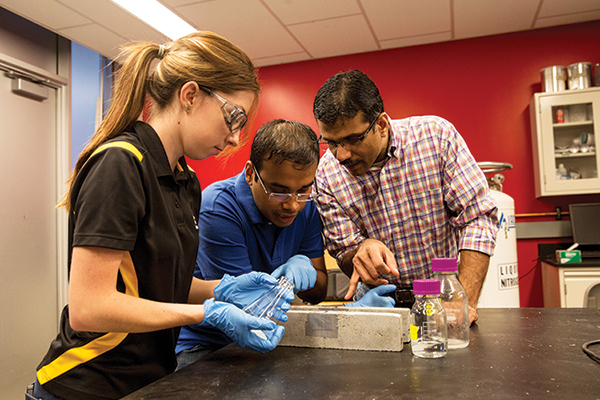Rubberized Roads, Sustainable Concrete and Smart Bridges
Researchers are exploring new materials and smart sensors, paving the way to better transportation infrastructure.
ROAD AND bridge building technology has changed little during the past several decades. But researchers at Arizona State University are exploring new techniques for building transportation infrastructure that will last longer, cost less and protect the environment as well as human lives.
Rubbery Roads and Sustainable Cement
ASU engineering professor Kamil Kaloush tests and recommends improvements to pavement performance. His team found that materials for roads can be made better by including a special ingredient derived from cars themselves: recycled tires.
Producers process the tire scraps and grind them into a material called crumb rubber. The rubber reacts as an enhanced elastic component when mixed with asphalt cement. The mixture forms rubberized or asphalt rubber pavement. This is one of the projects Kaloush oversees as director of the National Center of Excellence on SMART (Sustainable Materials and Renewable Technologies) Innovations at ASU.

Arizona State University Professor Narayanan Neithalath and Assistant Research Professor Sumanta Das work with a student in their lab to test new materials for roads and bridges. Photo by Nick Narducci
Rubberized pavement has many benefits. Just like the egg in a recipe for chocolate chip cookies, rubber makes roads much more resistant to cracking. That results in less maintenance over time, as well as a smoother and safer ride for drivers.
“Reduced deformation and cracking translates into road-user benefits such as better ride quality, less fuel consumption, lower maintenance frequencies and safer roadways,” Kaloush says.
The asphalt-rubber mixture is cost effective compared to conventional pavement and is better for the environment. Rubberized pavement is also stronger and better performing than traditional types, so it can be applied as a thinner layer, using less material. Because it incorporates recycled materials, rubberized pavement requires fewer natural resources to produce. Its smoother surface also reduces particle emissions from tire wear and tear, resulting in better air quality.
Because rubberized pavement is thinner than traditional pavement, it stores and gives off less heat. Researchers have shown this can help mitigate the urban heat island effect, which results when buildings and paved surfaces absorb and retain heat. Curbing that effect results in cooler temperatures both on and off the road.
Kaloush’s colleague Shane Underwood focuses on improving road materials down to the nanoscale. His team at ASU is adding tiny synthetic fibers to asphalt concrete. At just 10 microns in diameter, the fibers are about one-fourth the size of a human hair. But with a strength of 400,000 pounds per square inch, these tiny fibers are about six times stronger than most structural steel.
When a crack forms in traditional concrete, it gets wider and more severe over time. That’s because the weight of a load can’t be transferred across the concrete, causing the material to separate.
“When you’re driving down the road and you see a large crack, it didn’t just appear that way out of the blue. It got bigger over time,” Underwood says. The synthetic fibers his lab is testing help take on some of the weight from a passing vehicle. They reinforce the concrete and keep cracks from widening. This prevents water from getting in and making the damage even worse.
ASU engineering professor Narayanan Neithalath is also developing new materials for infrastructure. Some of his research focuses on longer-lasting concrete and cement for roads, bridges, tunnels and dams.
Portland cement is the most commonly used material for these projects, but it only lasts 20 to 25 years and has an environmental footprint like a fleet of Hummers. Neithalath wants to replace Portland cement with a material that lasts twice as long and requires fewer resources to manufacture, making it the Prius of the concrete world.
Kaloush says effective transportation infrastructure is a balancing act of durability, safety and efficient mobility of people and goods. In the future, those challenges will be compounded by the clashing of two forces: climate change and a rapidly growing population.
Brainy Bridges
Neithalath’s team is also hoping to advance another new area of infrastructure technology that borrows a technique from the medical field. Just as an electrocardiogram monitors the rhythm of a patient’s heart, Neithalath wants to develop sensors that monitor the health of the nation’s highways.
This technique is already in use. For example, the bridge that replaced Minnesota’s Interstate 35W is self-monitoring, with 323 fiber-optic sensors embedded in the concrete.
Neithalath’s team is working on a new, more accurate type of fiber-optic sensor. These sensors are coated in chemicals that react with the pavement to measure markers of deterioration. The sensors detect the presence of chlorides and sulfates, then transmit their findings back to engineers.
“For example, if you’re putting a lot of salt on your bridge and it starts to go through and corrode the steel, my fiber-optic sensors will tell me how much salt is inside the concrete,” Neithalath says.
Before sensors, the only way to determine a bridge or roadway’s health was to sever it open and peer between the cracks, or wait for a catastrophic failure. This new approach is like preventative medicine. As soon as the sensors detect vulnerability, they diagnose the problem and alert engineers that repairs are needed. Engineers can then order more tests or decide on a course of treatment.
Catching corrosion early on is especially important as more people move into cities. As urban populations grow, shutting down roads and bridges for major repairs becomes harder. With this in mind, ASU researchers want to build infrastructure that puts safety and sustainability on cruise control.
“We can use fewer resources, we can make bridges last longer and we can make them less risky,” Neithalath says. “Sustainability is a collaboration of all these different things.”
Allie Nicodemo, science writer, Office of Knowledge Enterprise Development, ASU
This article is adapted from one that originally appeared on research.asu.edu.




